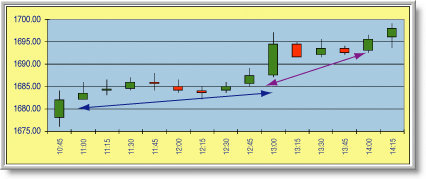The Range Is Narrow, But Opportunity Is There
Trading In Restrictive Intraday Price Ranges
by Anthony Trongone, PhD, CFP, CTA
When the commodity markets are moving in a narrow price range, are there any trading opportunities? Discover how you can find them and take immediate action in the emini NASDAQ 100.
The commodities markets are notorious for their price fluctuations. Still, there are occasions when they appear directionless. But after experiencing two hours of relatively narrow price movements, does it offer us a (profitable) trading opportunity? Let's take a look, confining our analysis to trading the emini NASDAQ 100 (NQs) between 8:30 am to 4:15 pm. During the 156 trading days I examined, there were 96 trading opportunities, of which 61 were profitable and 29 not, leaving us with six ties.
After breaking the 8:30 am-4:15 pm trading day into 15-minute segments, I started by looking at the price difference between the opening and the closing prices within each 15-minute bar. A relatively narrow price movement occurs when the bars stay within a two-point range (opening - closing price is within 2.00 index points). On the NQs, this restriction amounts to a monetary change less than $40, whereas the October 18, 2005-May 26, 2006, average difference was $36.60 (1.81 points).
The "120-60" system offers a trading opportunity when there are eight consecutive 15-minute bars all within a $40 range (2.00 index points). Once such a "stagnant run" occurs, you buy the futures contract during the close of the eighth consecutive bar. After one hour of trading (four consecutive bars), you offset your long position.
Figure 1 describes how to play this 120-60 system. A blue line indicates a tradable play in action because it is the start of eight consecutive 15-minute sessions. In this example, our trading decision comes from the bars trading between 11:00-13:00 -- that is, from the opening bar at 11:00 to the closing price at the 12:45 bar, which is at 13:00 (12:45 plus 15 minutes).

FIGURE 1: THE 120-60 SYSTEM. There are two components to trading this system: the blue line gives you the signal, and the purple line is the length of the trade. A portion of the success (61 winning, 29 losing trades, six ties) comes from reacting to the upward movement of the blue line.
Basically, you are looking at 120 minutes of trading, broken down
into eight 15-minute sessions. Since you are discounting the movement of
the wicks (the highest and lowest prices), your attention is on the length
of the actual bar. When each of the eight 15-minute sessions' opening price
lies within two points of the closing price, you have a tradable play.
Thereafter, you take a long position at the closing price of the eight
consecutive bars, which would occur at 13:00.
...Continued in the October issue of Technical Analysis of STOCKS
& COMMODITIES
Excerpted from an article originally published in the October 2006 issue of Technical Analysis of STOCKS & COMMODITIES magazine. All rights reserved. © Copyright 2006, Technical Analysis, Inc.
Return to October 2006 Contents